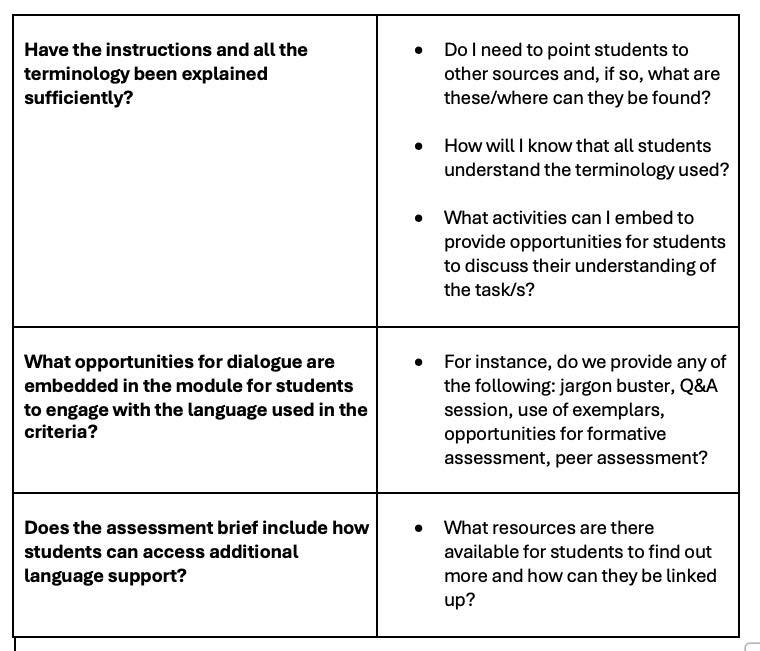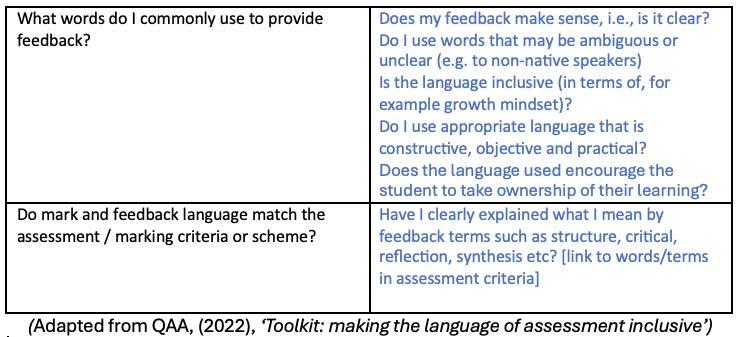

ADDRESSING LANGUAGE
A GUIDE TO ASSESSMENT



ADDRESSING LANGUAGE - A GUIDE TO ASSESSMENT

Language plays a crucial role in the assessment process in higher education. Effective communication, clarity, and inclusivity in language use are essential for fair and equitable assessments. This guide aims to provide you with strategies to address language considerations in assessment design, delivery, and feedback.
Why is language important?
Language influences students' understanding of assessment tasks, their performance, and how they interpret both the brief, the assessment task and their feedback. Clear and precise language helps ensure that all students, regardless of their background, have an equal opportunity to demonstrate their knowledge and skills (Brown, 2015). Inclusive language practices in assessments can help mitigate potential disadvantages faced by international speakers, students with disabilities, and those from diverse cultural backgrounds (QAA, 2022).
Inclusive Language in Assessment 1.Clarity and Precision
Assessment tasks should be written in clear, straightforward language to avoid misunderstandings. Avoiding jargon, ambiguous terms, and overly complex sentences can help students better understand what is expected of them (Race, 2014). Please consider terminologies through your assessment tasks such as asking student to ‘critical analyse’. Ask yourself if your students would understand what this means and how to apply it to their assessment.
Example:
This example from the QAA is good and gets us to think about language used in assessment; “Consider the following scenario: You are new to your institution and have inherited a range of units as unit leader; one of the units appears to have been assessed most exclusively by instructing students to ‘critically analyse’ a generic quote” (QAA, 2022: 2) How do you know that the students understand what is meant by this? What can you do to mitigate issues and concerns student may have on this?
The QAA continues by suggesting some prompts to guide you in addressing the complex languages used in assessment tasks and ways you might adapt these to be more inclusive for your student:


2. Cultural Sensitivity
Language used in assessments should be culturally neutral to ensure that no student is disadvantaged by cultural biases. This includes avoiding idiomatic expressions, metaphors, or references that may not be universally understood (Hyland, 2013).
Example:
Instead of using sports metaphors to measure success like "hit a home run" or "move the goalposts," use more universally understood phrases like "achieve success" or "change the criteria."

3. Accessibility
Assessment materials should be accessible to all students, including those with disabilities. This includes providing materials in alternative formats (e.g., Braille, large print) and using language that is accessible to students with varying levels of language proficiency (AdvanceHE, 2022). Do look at the BDA guidelines on how to format your unit handbooks.
4. Gender-Neutral Language
Using gender-neutral language helps avoid reinforcing gender stereotypes and ensures inclusivity. This includes using terms like "they/ them" instead of "he/she" and avoiding gendered terms where possible (Miller, 2019).
Designing Inclusive Assessments
1. Clear Instructions
Provide clear, concise instructions for assessment tasks. Use bullet points or numbered lists to break down complex instructions and highlight key points (Brown, 2015).
Example:
Instructions:
1. Read the case study.
2. Identify the main issues presented.
3. Discuss possible solutions using relevant theories.
2. Explicit Criteria
Clearly articulate the assessment criteria and provide examples of what constitutes excellent, good, and satisfactory performance. This transparency helps all students understand what is expected and how they can achieve the best possible outcomes (Race, 2014). A great way to embed this is through peer assessment at the unit briefing. Get student to mark previous cohorts work against the unit learning objectives and UCA’s grading criteria.
Example:
Assessment Criteria:
• Understanding of key concepts (30%)
• Application of theories to the case study (40%)
• Quality of argument and critical analysis (20%)
• Clarity of expression and organization (10%)
3. Diverse Assessment Methods
Utilise a variety of assessment methods to cater to different learning styles and abilities. This could include written assignments, presentations, group projects, and practical assessments (QAA, 2018). Offering choices in assessment methods can help accommodate diverse student needs and preferences.

4. Formative Assessments
Incorporate formative assessments to provide ongoing feedback and support. Formative assessments help students understand their progress and areas for improvement before final summative assessments (Black & Wiliam, 2009). Fir further support and guidance on how to incorporate formative assessment, you can view our formative assessment PDF guide and Lite Learn video.
5.
Inclusive Feedback
Provide feedback that is constructive, specific, and focused on improvement. Use language that is encouraging and supportive, and ensure that feedback is understandable to all students, including those with varying levels of language proficiency (Hyland & Hyland, 2006).
Example:
Instead of saying, "This section is unclear," provide specific guidance: "In this section, try to explain the concept of globalization more clearly by providing examples from the text."

Addressing Language Barriers
1. Support for students with English as an Additional Language
Provide additional support for whom English is not their first language by embedding language workshops and tutoring services from the EAP teams. Encouraging peer support and study groups can also help students improve their language skills (Hyland, 2013).
2. Use of Plain Language
Ensure that assessment materials are written in plain language that is easily understood by all students. Avoid complex vocabulary and long sentences, and provide glossaries for technical terms (Race, 2014).
3. Translation and Interpretation Services
Where possible, offer translation and interpretation software for students who require them. This can help ensure that all students have a fair opportunity to understand and complete assessments (AdvanceHE, 2022).
Conclusion
Addressing language in assessment is crucial for ensuring fairness and inclusivity in higher education. By adopting clear, culturally sensitive, and accessible language practices, educators can help all students succeed. Adhering to the guidelines provided by the QAA and OfS further supports the creation of equitable assessment environments. Through ongoing reflection and adaptation of assessment practices, we can all continue to improve the inclusivity and effectiveness of our assessments.
Resources:

AdvanceHE, 2022. Assessment and Feedback in Higher Education. Available at: https:// www.advance-he.ac.uk/teaching-and-learning/assessment-and-feedback-higher-education.(accessed 8th August 2024)
Black, P. and Wiliam, D. 2009. Developing the theory of formative assessment. Educational Assessment, Evaluation and Accountability, 21(1), pp. 5-31. Available at: https://kclpure.kcl.ac.uk/ws/ portalfiles/portal/9119063/Black2009_Developing_the_theory_of_formative_assessment.pdf (accessed 7th August 2024)
Brown, S. 2015. Assessment for Learning. London: Routledge.
Hyland, K. & Hyland, F. 2006. Feedback in second language writing: Contexts and issues. Cambridge: Cambridge University Press.
Miller, C. 2019. Inclusive Language and Practices in Higher Education. London: Sage.
Office for Students (OfS), 2021. Delivering positive outcomes for all students: consultation on a new approach to regulating equality of opportunity in English higher education. Available at: https:// www.officeforstudents.org.uk/publications/ (accessed 7 August 2024)
Quality Assurance Agency (QAA), 2018. UK Quality Code for Higher Education. [online] Available at: https://www.qaa.ac.uk/quality-code (accessed 7 August 2024)
Quality Assurance Agency. 2022. Toolkit: making the language of assessment inclusive. Available at: https://www.qaa.ac.uk/docs/qaa/members/toolkit-making-the-language-of-assessmentinclusive.pdf?sfvrsn=4f3a981_6 (accessed 7th August 2022)
Race, P. 2014. Making Learning Happen: A Guide for Post-Compulsory Education. Available at: https://www.researchgate.net/ publication/264680423_Making_Learning_Happen_A_Guide_for_PostCompulsory_Education_By_Phil_Race_Thousand_Oaks_Calif_Sage_Publications_2010_xi_250_pag es_ISBN_978-1-84920-114-8_4495 (accessed 7th August 2024)




